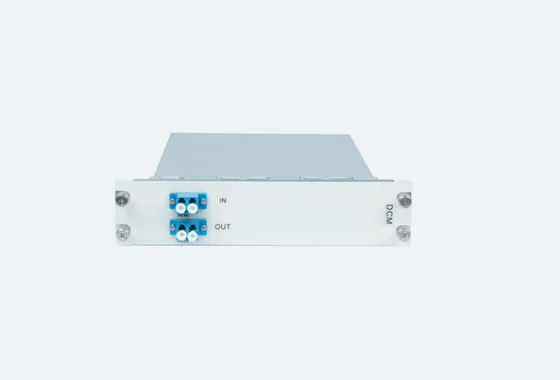Precision in Long-Haul Networks: Unleashing the Power of 100km Dispersion Compensation Fiber

In the rapidly evolving landscape of optical communication systems, ensuring the transmission of high-bandwidth signals over long distances with minimal signal degradation is crucial. One of the key factors affecting the efficiency of long-distance fiber optic communication is chromatic dispersion, which leads to pulse broadening and signal distortion as data travels through optical fibers. To mitigate these issues and maintain the integrity of the signal, dispersion compensation fiber (DCF) plays a critical role. Specifically, the 100km dispersion compensation fiber has emerged as a solution to address the challenges posed by chromatic dispersion in high-speed, long-haul optical networks. This article WDMLight delves into the applications of 100km dispersion compensation fiber, highlighting its significance in modern telecommunications.
What is 100km Dispersion Compensation Fiber?

100km dispersion compensation fiber is a specially designed type of optical fiber that is engineered to counteract the chromatic dispersion effects experienced in long-haul optical communications. It is characterized by its ability to provide dispersion compensation over a distance of 100 kilometers, helping to preserve the signal's quality over extended transmission distances.
Dispersion compensation fibers are typically made from a material different from standard single-mode fibers, with properties that counterbalance the dispersion that occurs in the primary transmission fiber. The 100km dispersion compensation fiber is optimized for use in systems that require long-distance signal transmission, such as submarine cable systems, terrestrial networks, and high-capacity data links. By using this fiber, network operators can reduce the need for frequent regeneration or amplification of the signal, resulting in lower operational costs and improved system performance.
Applications of 100km Dispersion Compensation Fiber
The unique characteristics of 100km dispersion compensation fiber make it suitable for various applications in optical networks, particularly those requiring long-distance, high-capacity transmission. Some of the key applications include:
1. Long-Haul Telecommunication Networks
In long-haul telecommunication networks, the transmission distance between communication nodes can be hundreds or even thousands of kilometers. As the signal travels along the optical fiber, it accumulates dispersion, which can significantly degrade the quality of the transmitted data. The 100km dispersion compensation fiber is strategically placed at various intervals along the fiber optic route to compensate for the dispersion effects, ensuring that the signal remains sharp and intelligible over the long distance. This is especially important for metropolitan and regional backbones that connect major cities and countries, as well as submarine cable systems that cross oceans.
2. Dense Wavelength Division Multiplexing (DWDM) Systems
Dense wavelength division multiplexing (DWDM) is a key technology used in high-capacity fiber optic networks. It allows multiple data channels to be transmitted simultaneously over a single optical fiber, each at a different wavelength. However, as the number of channels increases and the transmission distances become longer, chromatic dispersion becomes a more significant issue. By using 100km dispersion compensation fiber, operators can ensure that each channel is unaffected by the dispersion of the other channels, preserving the integrity of the entire signal. This is crucial in DWDM systems, where even small amounts of dispersion can lead to inter-channel interference and a loss of data integrity.
3. Submarine Cable Systems
Submarine cable systems are the backbone of international communication, providing high-speed data transmission between continents. These systems typically span thousands of kilometers and use optical fibers to transmit signals at high speeds. The 100km dispersion compensation fiber is an essential component in such systems, as it helps mitigate the effects of dispersion over vast distances. By incorporating this fiber, network operators can reduce the need for signal regeneration and improve the overall performance and reliability of the system.
4. Data Centers and Cloud Networks
With the growing demand for high-speed internet and cloud services, data centers are under increasing pressure to deliver large volumes of data with low latency. In these environments, the need for efficient long-distance communication links is paramount. The 100km dispersion compensation fiber plays an essential role in ensuring the reliable transmission of data between data centers, particularly in large-scale cloud networks that rely on fiber optic infrastructure. By reducing the impact of chromatic dispersion, it enables data to travel faster and with fewer errors, supporting the high-performance requirements of modern data centers.
The integration of 100km dispersion compensation fiber into optical networks has revolutionized the way long-distance communication systems operate. By addressing the challenges of chromatic dispersion, this fiber solution ensures high-quality, high-capacity transmission over extended distances, enabling faster and more reliable data communication. As the demand for high-speed data continues to rise, particularly in telecommunication, cloud services, and global networks, the role of dispersion compensation fiber, especially the 100km variant, will remain integral in maintaining the performance and efficiency of modern optical systems. Its ability to enhance signal integrity, reduce operational costs, and optimize network performance makes it a vital component in the ongoing evolution of global optical communications.
https://www.wdmlight.com/100km-Dispersion-Compensation-Fiber.html
www.wdmlight.com
WDMLight